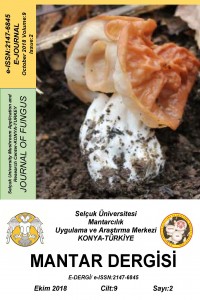Öz
In this study, Suillus lakei
(Murrill) A.H. Sm. & Thiers) was reported for the first time from Turkey. This
species is characterized by its ectomycorrhizal
features and
the occurrence under Pseudotsuga menziesii (Douglas
fir). Besides conventional identification methods, molecular methods (ITS rDNA)
were also used and results were uploaded to GenBank. According to the Genbank
results, our species shows 99% similarity to other data related to Suillus lakei. A short description with
molecular analysis were given in the text and the results discussed briefly.
Anahtar Kelimeler
Kaynakça
- Arora D. Mushrooms Demystified. Berkeley, CA, Ten Speed Press(1986).
- Assyov B., Stoichev G., Vassilev R., First records of mushroom species for Bulgaria”, Mycologia Balcanica, (3):127-30(2006).
- Barroetaveña C., Cázares, E., Rajchenberg M., Ectomycorrhizal fungi associated with ponderosa pine and Douglas-fir: a comparison of species richness in native western North American forests and Patagonian plantations from Argentina, Mycorrhiza, 17(5):355-73(2007).
- Kirk P., Cannon P.F., Minter D.W., Stalpers J.A., Ainsworth & Bisby’s Dictionary of the Fungi, 10th edn, CAB International, Wallingford, UK(2008).
- Lavorato C., Suillus nordamericani presenti in Calabria, Pagine di Micologia, 12:31-49(1999).
- Myra C.C., Grace L.J, Mycorrhizal fungi of Pseudotsuga menziesii in the south island of New Zealand, Soil Biology and Biochemistry 19(3):243-246(1986).
- Nguyen N.H., Kerekes J.F., Vellinga E.C., Bruns T.D., Synonymy of Suillus imitatus, the imitator of two species within the S. caerulescens/ponderosus complex, Mycotaxon, 122: 389-398(2012).
- Sarwar S., Khalid AN., Diversity and Phylogeny of Suillus (Suillaceae; Boletales; Basidiomycota) from Coniferous Forests of Pakistan, International Journal of Agriculture and Biology, 16:489-497(2014).
- Sesli E., Denchev C.M., Checklists of the myxomycetes, larger ascomycetes, and larger basidiomycetes in Turkey. Mycotaxon, 106:65-67(2008).
- Szczepkowski A., Olenderek T., Suillus lakei (Murrill) A. H. Sm. & Thiers (Boletales, Basidiomycota) in Poland: new data, Acta Mycologia, 52(in press)(2017).
- Valenzuela E., Esteve-Raventos, F., Algunos Agaricales s.l. aloctonos asociados a especies aroreas exoticas cultivadas en la decima region en Chile, Boletin Micologico, 14(1/2): 73-81(1999).
- Vasas G., Albert L., Interesting fungi from Hungary II. Basidiomycetes, Agaricale, Annales Historico-Naturales Musei Nationalis Hungarici, 82: 61–64(1990).
- White, T.J., Bruns, T., Lee, S., Taylor, J., Amplification and Direct Sequencing of Fungal Ribosomal RNA Genes for Phylogenetics. In: Innis, M.A., Gelfand, D.H., Shinsky, J.J. and White, T.J., Eds., PCR Protocols: A Guide to Methods and Applications, Academic Press, Inc., New York, 315-322(1990).
- Zahradka, F., Hrib douglaskovy - Boletinus lakei v okoli Dubnan u Hodonina, Mykologicky Sbornik, 82(1): 28-29(2005).
Öz
Bu çalışmada, Suillus
lakei (Murrill) A.H. Sm. & Thiers Türkiye’den ilk defa rapor
edilmiştir. Bu tür, ektomikorhizal özellikleri ve Pseudotsuga menziesii (Douglas göknarı) altında yayılış göstermesi
ile karakterize edilir. Geleneksel tanımlama yöntemlerinin yanı sıra moleküler
yöntemler de (ITS rDNA) kullanılmış ve sonuçlar GenBank'a yüklenmiştir. Genbank
sonuçlarına göre, örneklerimiz Suillus
lakei ile ilgili diğer verilere %99 benzerlik göstermektedir. Metinde
moleküler analizlerle birlikte kısa bir tanımlama verilmiş ve sonuçlar kısaca
tartışılmıştır.
Anahtar Kelimeler
Kaynakça
- Arora D. Mushrooms Demystified. Berkeley, CA, Ten Speed Press(1986).
- Assyov B., Stoichev G., Vassilev R., First records of mushroom species for Bulgaria”, Mycologia Balcanica, (3):127-30(2006).
- Barroetaveña C., Cázares, E., Rajchenberg M., Ectomycorrhizal fungi associated with ponderosa pine and Douglas-fir: a comparison of species richness in native western North American forests and Patagonian plantations from Argentina, Mycorrhiza, 17(5):355-73(2007).
- Kirk P., Cannon P.F., Minter D.W., Stalpers J.A., Ainsworth & Bisby’s Dictionary of the Fungi, 10th edn, CAB International, Wallingford, UK(2008).
- Lavorato C., Suillus nordamericani presenti in Calabria, Pagine di Micologia, 12:31-49(1999).
- Myra C.C., Grace L.J, Mycorrhizal fungi of Pseudotsuga menziesii in the south island of New Zealand, Soil Biology and Biochemistry 19(3):243-246(1986).
- Nguyen N.H., Kerekes J.F., Vellinga E.C., Bruns T.D., Synonymy of Suillus imitatus, the imitator of two species within the S. caerulescens/ponderosus complex, Mycotaxon, 122: 389-398(2012).
- Sarwar S., Khalid AN., Diversity and Phylogeny of Suillus (Suillaceae; Boletales; Basidiomycota) from Coniferous Forests of Pakistan, International Journal of Agriculture and Biology, 16:489-497(2014).
- Sesli E., Denchev C.M., Checklists of the myxomycetes, larger ascomycetes, and larger basidiomycetes in Turkey. Mycotaxon, 106:65-67(2008).
- Szczepkowski A., Olenderek T., Suillus lakei (Murrill) A. H. Sm. & Thiers (Boletales, Basidiomycota) in Poland: new data, Acta Mycologia, 52(in press)(2017).
- Valenzuela E., Esteve-Raventos, F., Algunos Agaricales s.l. aloctonos asociados a especies aroreas exoticas cultivadas en la decima region en Chile, Boletin Micologico, 14(1/2): 73-81(1999).
- Vasas G., Albert L., Interesting fungi from Hungary II. Basidiomycetes, Agaricale, Annales Historico-Naturales Musei Nationalis Hungarici, 82: 61–64(1990).
- White, T.J., Bruns, T., Lee, S., Taylor, J., Amplification and Direct Sequencing of Fungal Ribosomal RNA Genes for Phylogenetics. In: Innis, M.A., Gelfand, D.H., Shinsky, J.J. and White, T.J., Eds., PCR Protocols: A Guide to Methods and Applications, Academic Press, Inc., New York, 315-322(1990).
- Zahradka, F., Hrib douglaskovy - Boletinus lakei v okoli Dubnan u Hodonina, Mykologicky Sbornik, 82(1): 28-29(2005).
Ayrıntılar
| Birincil Dil | İngilizce |
|---|---|
| Bölüm | MİKOLOJİ |
| Yazarlar | |
| Yayımlanma Tarihi | 25 Ekim 2018 |
| Yayımlandığı Sayı | Yıl 2018 Cilt: 9 Sayı: 2 |
Uluslararası Hakemli Dergi
Dergimiz, herhangi bir başvuru veya yayımlama ücreti almamaktadır
Bu eser Creative Commons Atıf 4.0 Uluslararası Lisansı ile lisanslanmıştır.


